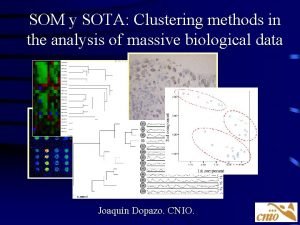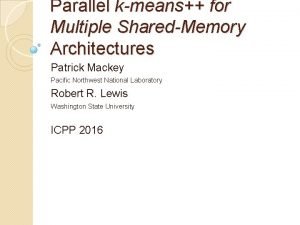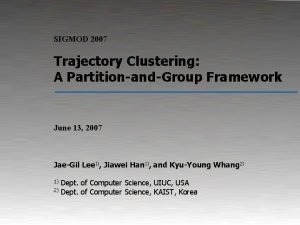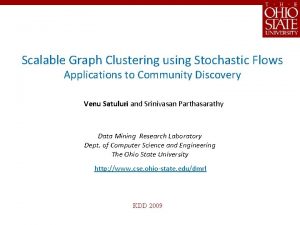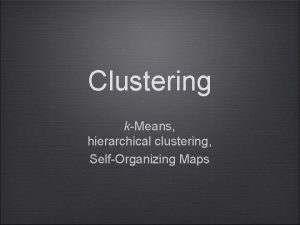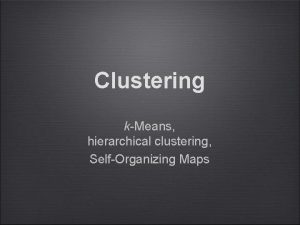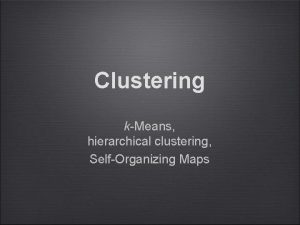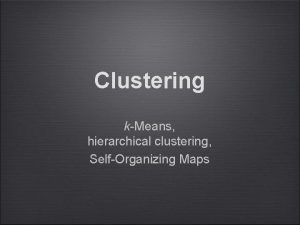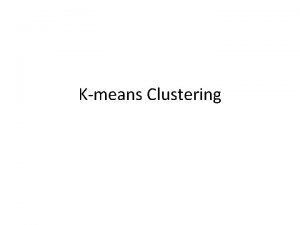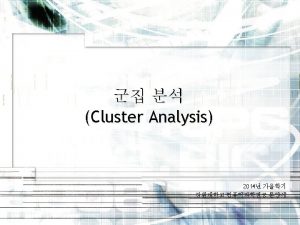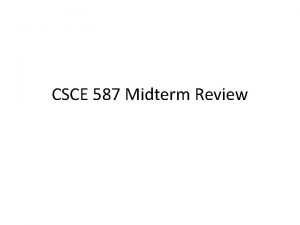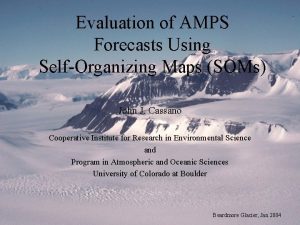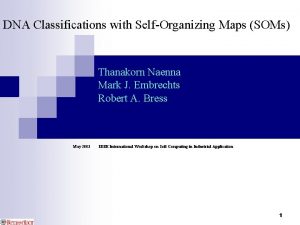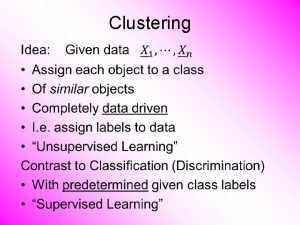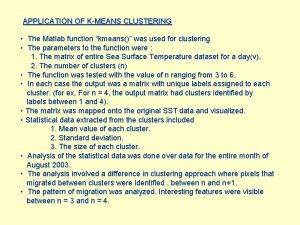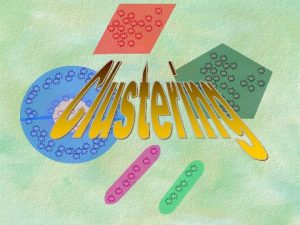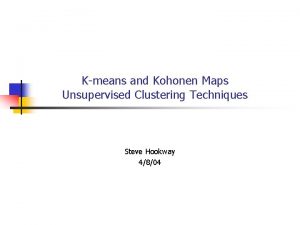Selforganizing maps SOMs and kmeans clustering Part 1




















- Slides: 20

Self-organizing maps (SOMs) and k-means clustering: Part 1 Steven Feldstein The Pennsylvania State University Collaborators: Sukyoung Lee, Nat Johnson Trieste, Italy, October 21, 2013

Teleconnection Patterns • Atmospheric teleconnections are spatial patterns that link remote locations across the globe (Wallace and Gutzler 1981; Barnston and Livezey 1987) • Teleconnection patterns span a broad range of time scales, from just beyond the period of synoptic-scale variability, to interannual and interdecadal time scales.

Methods for Determining. Teleconnection Patterns • • • Empirical Orthogonal Functions (EOFs) (Kutzbach 1967) Rotated EOFs (Barnston and Livezey 1987) One-point correlation maps (Wallace and Gutzler 1981) Empirical Orthogonal Teleconnections (van den Dool 2000) Self Organizing Maps (SOMs) (Hewiston and Crane 2002) k-means cluster analysis (Michelangeli et al. 1995)

Advantages and Disadvantages of various techniques • Empirical Orthogonal Functions (EOFs): patterns maximize variance, easy to use, but patterns orthogonal in space and time, symmetry between phases, i. e. , may not be realistic, can’t identify continuum • Rotated EOFs: patterns more realistic than EOFs, but some arbitrariness, can’t identify continuum • One-point correlation maps: realistic patterns, but patterns not objective organized, i. e. , different pattern for each grid point • Self Organizing Maps (SOMs): realistic patterns, allows for a continuum, i. e. , many NAO-like patterns, asymmetry between phases, but harder to use • k-means cluster analysis: Michelangeli et al. 1995

The dominant Northern Hemisphere teleconnection patterns North Atlantic Oscillation Pacific/North American pattern Climate Prediction Center

Aim of EOF, SOM analysis, and kmeans clustering • To reduce a large amount of data into a small number of representative patterns that capture a large fraction of the variability with spatial patterns that resemble the observed data

Link between the PNA and Tropical Convection Enhanced Convection From Horel and Wallace (1981)

P 1=1958 -1977 P 2= 1978 -1997 P 3=1998 -2005 A SOM Example Northern Hemispheric Sea Level Pressure (SLP)

Another SOM Example (Higgins and Cassano 2009)

A third example

How SOM patterns are determined • Transform 2 D sea-level pressure (SLP) data onto an N-dimension phase space, where N is the number of gridpoints. Then, minimize the Euclidean between the daily data and SOM patterns where is the daily data (SLP) in the N-dimensional phase, are the SOM patterns, and i is the SOM pattern number.

How SOM patterns are determined • E is the average quantization error, The (SOM patterns) are obtained by minimizing E.

SOM Learning Initial Lattice (set of nodes) BMU Data Randomlychosen vector Nearby Nodes Adjusted (with neighbourhood kernel) Convergence: Nodes Match Data

SOM Learning • 1. Initial lattice (set of nodes) specified (from random data or from EOFs) • 2. Vector chosen at random and compared to lattice. • 3. Winning node (Best Matching Unit; BMU) based on smallest Euclidean distance is selected. • 4. Nodes within a certain radius of BMU are adjusted. Radius diminishes with time step. • 5. Repeat steps 2 -4 until convergence.

How SOM spatial patterns are determined • Transform SOM patterns from phase space back to physical space (obtain SLP SOM patterns) • Each day is associated with a SOM pattern • Calculate a frequency, f, for each SOM pattern, i. e. , f( ) = number of days is chosen/total number of days

SOMs are special! • Amongst cluster techniques, SOM analysis is unique in that it generates a 2 D grid with similar patterns nearby and dissimilar patterns widely separated.

Some Background on SOMs • SOM analysis is a type of Artificial Neural Network which generates a 2 -dimensional map (usually). This results in a low-dimensional view of the original high-dimension data, e. g. , reducing thousands of daily maps into a small number of maps. • SOMs were developed by Teuvo Kohonen of Finland.

Artificial Neural Networks • Artificial Neural Networks are used in many fields. They are based upon the central nervous system of animals. • Input = Daily Fields • Hidden = Minimization of Euclidean Distance • Output = SOM patterns

A simple conceptual example of SOM analysis Uniformly distributed data between 0 and 1 in 2 -dimensions

A table tennis example (spin of ball) Spin occurs primarily along 2 axes of rotation. Infinite number of angular velocities along both axes components. Joo Sae. Hyuk • • 주세혁 Input - Three senses (sight, sound, touch) feedback as in SOM learning Hidden - Brain processes information from senses to produce output Output - SOM grid of various amounts of spin on ball. SOM grid different for every person
 Flat and hierarchical clustering
Flat and hierarchical clustering Bond energy algorithm
Bond energy algorithm Rumus euclidean distance
Rumus euclidean distance Sota clustering
Sota clustering Javascript kmeans
Javascript kmeans Patrick mackey
Patrick mackey Welkom in het eerste leerjaar
Welkom in het eerste leerjaar Soms of sam
Soms of sam Google map reittihaku
Google map reittihaku The trajectory
The trajectory Classification and clustering in data mining
Classification and clustering in data mining Classification and clustering
Classification and clustering Part whole model subtraction
Part whole model subtraction Part to part ratio definition
Part to part ratio definition Part part whole
Part part whole Part by part technical description example
Part by part technical description example Parts of the bar drawing
Parts of the bar drawing The part of a shadow surrounding the darkest part
The part of a shadow surrounding the darkest part 미니탭 gage r&r 해석
미니탭 gage r&r 해석 Clustering vs classification
Clustering vs classification Graclus
Graclus



